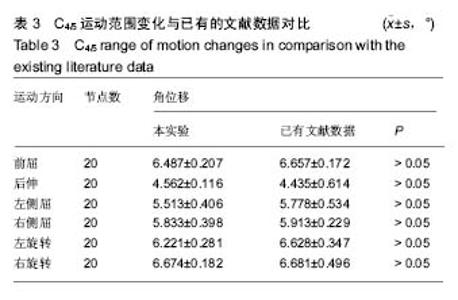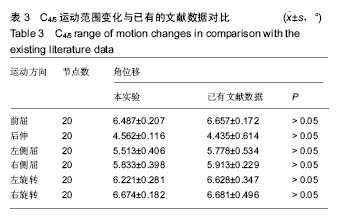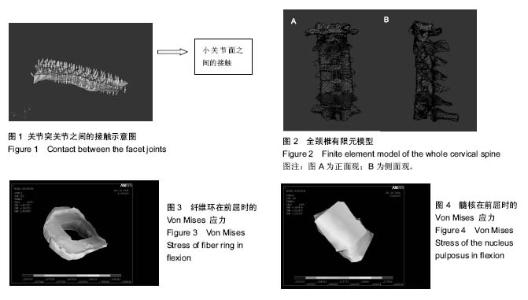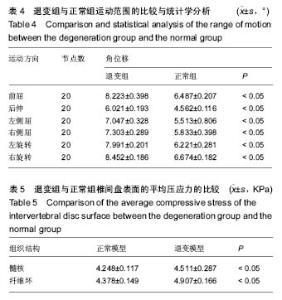| [1] Lan J,Chen QX,Zhai XJ .The change of shape and curvature in degenerative lumbar disc and its clinical significance.Chin J Clin Anat.2005;23(2):157-159 .[2] Sairyo K,Geol VK,Masuda A,et al.Three—dimensional finite elementanalysis of the pediatric lumbar spine.Part I:pathomechanism of apophyseal bony ring fracture.Eur Spine Journal.2012;15(6):923-929.[3] 王辉昊,詹红生,陈博,等.正常人全颈椎(C0-T1)三维有限元模型的建立与验证[J].生物医学工程学杂志,2014,31(6):1243-1248.[4] 张国强,张京新,鲁世保,等. 颈椎间盘置换治疗颈椎病术后相邻节段退变的临床观察[J].中国矫形外科杂志, 2016,24(13): 1184-1188.[5] Chen xinmin,Lang jixiao,Chen dexi,et al.3D finite element analysis of biomechanical significance in the attribute selection of three-dimensional finite element model materialof pelvis and acetabulum.Chinese J Clin Rehabil, 2005;9(2): 71-73 .[6] Ha SK.Finite element modeling of multi-level cervical spinal segments(C3-C6)and biomechanical analysis of an elastomer-type prosthetic disc.Med Eng & Physics. 2006; 28(8):534-541 . [7] 赵刘军,柴波,蒋维宇,等.下颈椎前路椎弓根螺钉配套钢板系统的生物力学性能研究[J].中华实验外科杂志, 2014,31(2): 385-388.[8] WuC,Chen C,Wu W,et.al.BiomeehanicaI analysis of differentialpull.out strengths of bone screws using cervical anterior transpedieulartechnique in normal and osteoporotic cervieal cadavefic spine.Spine(Phila Pa 1976).2015;40(1): E1-E8[9] 苏晋,赵文志,陈秉智,李斌等.椎板不同切除范围对腰椎生物力学影响的三维接触有限元分析[J].生物医学工程学杂志, 2012, (3):645-651.[10] Sairyo Geol VK,Vadapalli S,et al.Biomechanieal comparison of lumbar spine with or without spine bifida oeculta.A finite element analysis.Spinal Cord.2010;44(7):440-444.[11] 李斌,赵文志,陈秉智,等.颈椎人工椎间盘植入术后临近节段生物力学变化的有限元分析[J].医用生物力学杂志,2010,25(02): 94-99.[12] Zhong ZC,Wei SH,Wang JP,et al.Finite element analysis of the lumbar spine with a new cage using a topology optimization method.MedEng Phys.2015;28(1):90-98.[13] Murata M, Morio Y, Kuranobu K.Lumbar disc degeneration and segmental instability:a comparison of magnetic resonance images and plain radiographs of patients with low back pain.Arch Orthop Trauma Surg.1994;113:297-301.[14] 李龙,陈阳,周建伟,等.前后路全脊椎切除治疗下颈椎原发肿瘤[J].实用骨科杂志,2014,20(5):401-404.[15] Duan Y,Wang HH,Jin AM,et al.Finite element analysis of posterior cervical fixation.Orthop Traumatol•Sur.2015;101: 23-29.[16] 詹世强,昌耘冰,顾宏林,等.Discover人工颈椎间盘置换治疗颈椎间退变性疾病的早中期疗效及并发症分析[J].中国矫形外科杂志, 2016,24(5):385-390.[17] 刘瑞端,肖荣驰,唐志宏,等.单节段颈椎间盘置换术对相邻颈椎节段退变的影响[J]. 中国骨与关节损伤杂志,2015,30(5): 452-455.[18] Zhong ZC,Wei SH,Wang JP,et al.Finite element analysis of the lumbar spine with a new cage using a topology optimization method.Med Eng Phys.2006;28(1):90-98.[19] Brolin K,Halldin P.Development of a finite element model of the upper cervical spine and a parameter study of ligament characteristics.Spine.2004;29 (4):376 .[20] Galbusera F,Fantigrossi A, Raimondi MT,et al.Biomechanics of the C5-C6 spinal unit before and after placement of a disc prosthesis.Biomechanics and Modeling in Mechanobiology. 2006;5(4):253-261 . [21] Teo EC,Ng HW.Evaluation of the role of ligaments ,facets and disc nucleus in lower cervical spine under compression and sagittal moments using FA method .Med Eng Phys.2001; 23(3):155-164 .[22] 张昊,白净.颈椎有限元模型的建立方法及进展[J] .国外医学生物医学工程分册,2005,28(4):198-253 .[23] 杜瑞卿,陈以国,张鹏,等.脊柱生物力学有限元分析法的概述[J].北京生物医学工程,2004,1(23):78-80 .[24] 王友良,杨杰山.三维有限元分析在颈椎生物力学中的研究现状[J].临床骨科杂志2011,14(1):89-92.[25] 孟庆华,鲍春雨,刘晋浩.人体脊柱全颈椎三维有限元模型研究与应用[J].医用生物力学,2009,24(3):178-182,[26] 郭炯炯,杨惠林,朱雪松,等.中国南方人群腰椎间盘退变的影像学和流行病学研究[J].中华骨科杂志,2014,34(5):546-552.[27] Nuser ZP,Kuelling FM,Liu JM,et al.Biological and Biomechanical Effects of Fibrin Injection Into Porcine Intervertebral Discs. Spine. 2011;36(18):1201-1209.[28] Kirkaldy WH,Bemard TN Jr.Managing low back pain.4th ed.New Yofk:Churchill Livingstone.1999;390-419. |





